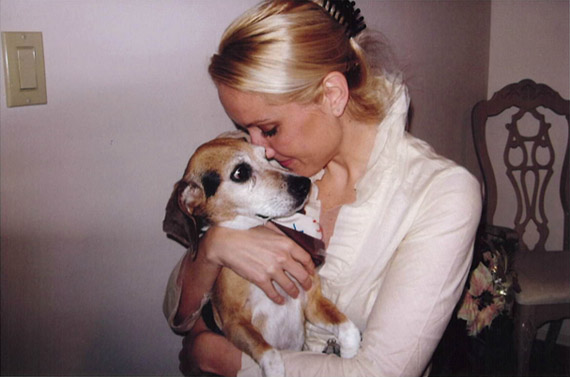Letters to Pushkin: From Loss to Inspiration & Healing
Iwas blessed to have Pushkin in my life and in our home for just over nine years. Throughout the years, he continually proved himself a resilient but gentle soul. He was feisty. He was peaceful. He was funny. Simply put, his spirit was just too big and too wonderful to keep all to myself. When people hear about Pushkin, I want them to smile, to laugh, to feel a hint of the joy he brought – and continues to bring – to my life every single day.
Pushkin and I first met each other on Thanksgiving weekend in 1999 at New York City’s Bideawee, a humane organization located in Midtown. I will never forget that first time our eyes met. Pushkin was about two and a half years old and called “Dennis” at the time, and he was being held in a pen with a few larger dogs. He looked up with his big deer-like eyes, and I became an instant believer in love at first sight. It was the beginning of a beautiful friendship that would take us from New York to Tucson, where we continued to build our family – adding my husband and two canine brothers for Pushkin to the pack.
On Sunday morning, February 1, 2009, Pushkin went to sleep in my arms for the last time. Three and a half weeks later, it was Ash Wednesday, which marks the beginning of the Catholic Church’s Lent season. When you’re younger, Lent is usually about giving up something like chocolate for 40 days.
Letters to Cope with Loss
And so I began writing on Ash Wednesday, February 25th, and the final letter was written on Easter Sunday, April 12th. My 47 letters document my personal healing process. As I went through the predictable emotional ups and downs throughout the course of these seven weeks, plenty was happening around me. However, at the end of the process, I realized I was just at another beginning – albeit, a hopeful one.
On a very practical level, writing a letter each day in the weeks after Pushkin’s passing enabled me to quietly spend some time with him each day as I was still getting used to not having him around the house anymore. In each letter, I also spent some time sorting through my ideas about life and death – drawing from various ideas in literature, philosophy and religions. It was a time when I was trying to figure out what I believed in largely so that I could put Pushkin, in my own mind (and heart), in a safe and peaceful place. The letters are emotional; but rather than dwelling on depressing thoughts, I could have a kind of conversation with Pushkin and include him in the day-to-day, including the usual mix of life events, such as friends visiting or my decision to go to law school to focus on Animal Law.

© Sharon Discorfano
Looking back on the letters now, I can see the healing going on, leading up to a very hopeful final letter written on Easter Sunday. Ultimately, writing the letters was a big part of me letting my relationship with Pushkin evolve so that he could still be present in my life and continue to inspire me as he does.
A Supportive Community
Having found letter writing so helpful, I wanted to create a place where others could do the same. With my technology-savvy husband’s help, www.letterstopushkin.com was born and, through word of mouth, has become a hub of support and healing for many. Visitors to the site find comfort, first, in knowing other people are out there who understand the depth of grief from losing a companion animal. These people understand that companion animals are family members and losing them can hurt just as much as losing a human family member.
Second, the site allows people who aren’t ready to write a letter of their own to find comfort in the words of others. Reading others’ letters can help them feel less alone in their grief. Those writing letters of their own have shared that the experience has been very cathartic for them. They have been happy to know that, in sharing, they could offer their family and friends a way to better understand what they were going through – and also help strangers coping with a similar loss.
While much of the grieving and healing process is deeply personal and requires quiet reflection, it is also a process in which one can benefit greatly from connections we make with others.
Unfortunately, this kind of support is not always readily available to someone going through the grieving process. The Letters To Pushkin (LTP) site remains comment-free so people can write without having to worry about others’ reactions. However, the LTP Facebook page has become a tremendous support network where people so generously offer words of support and comfort to each other.
Pushkin’s Legacy
Beyond the web site, those who have read the collection of letters I wrote to Pushkin, now available in book form, have responded very positively. Many enjoy the book as an opportunity through my letters not only to experience my very personal healing process in more detail but also to get to know Pushkin a little better through the anecdotes I share and events that transpire during the course of my writing. Also, 50 percent of royalties from the book goes to Bideawee, the organization that brought Pushkin and me together. In this way, Pushkin lives on helping both people and animals in need.
When people ask me how Pushkin has influenced my life, I tell them that a brilliant spirit came to me in a 24-pound beagle body that opened my heart. I am a more compassionate person because of him. I have a greater awareness of how interconnected we all are and a greater sense of responsibility towards all living things. Pushkin also opened my eyes to how much animals need our help; they need us to lend them our voices. In this respect, he helped steer my life in a new direction as I have become focused on animal-related legal issues and advocacy. He, along with his brothers Otis and Galileo, is at the heart of all my work in animal advocacy. And by sharing Pushkin with others, so much good has come out of his life and the loss I experienced. It warms my heart knowing that others have been touched by his life, also finding inspiration and healing.

© Sharon Discorfano




























